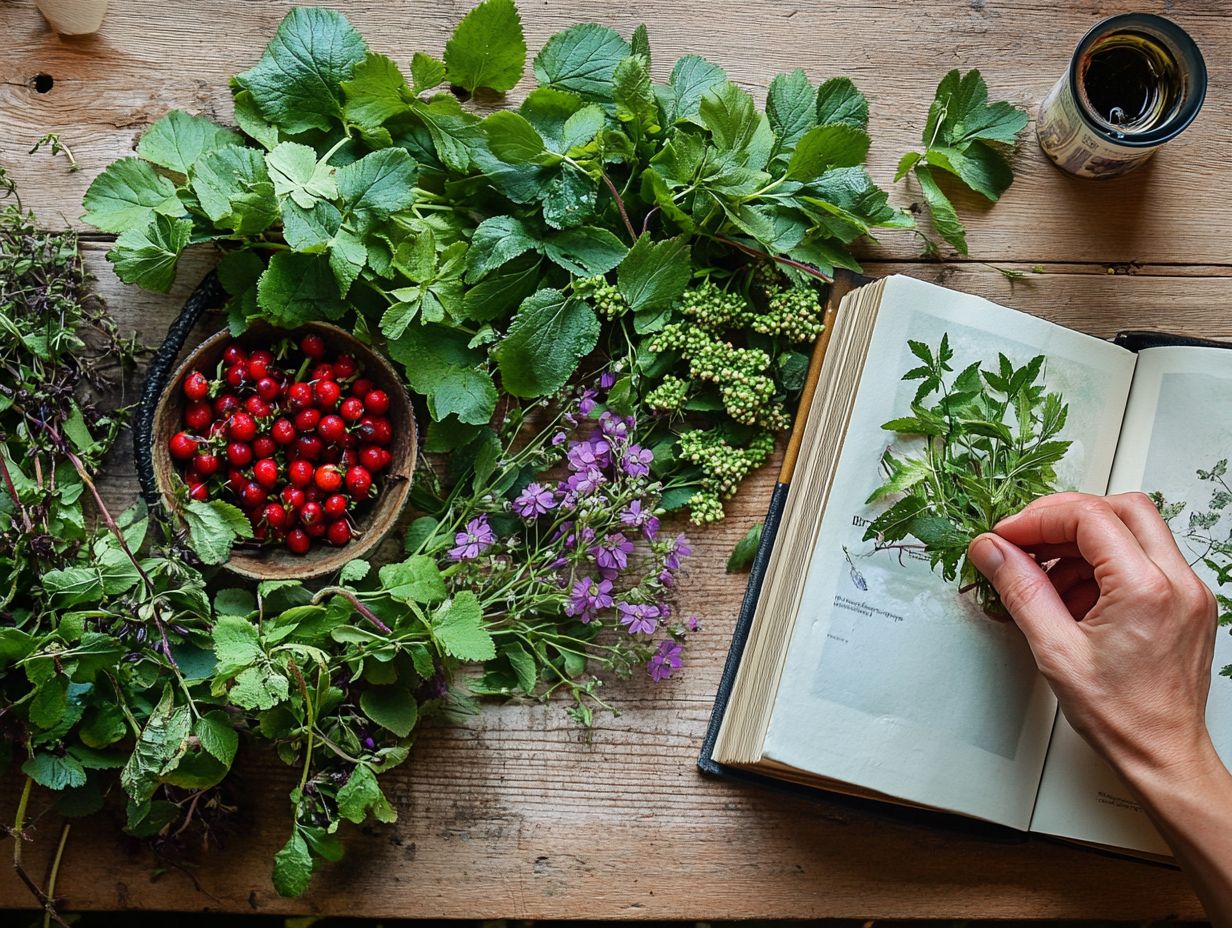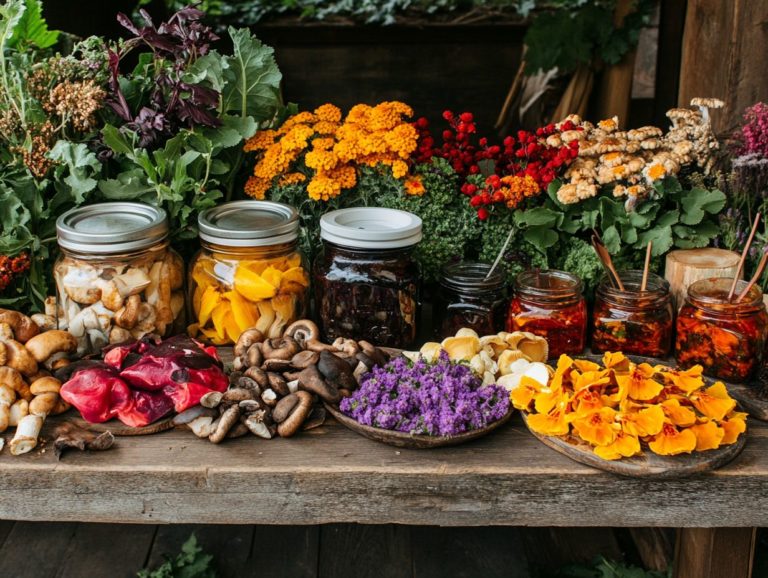Identifying Wild Edibles in Your Local Area
Exploring the world of wild edibles presents an exhilarating and rewarding adventure. These remarkable plants not only offer a unique culinary experience but also forge a deeper connection to nature and the ecosystem surrounding you.
This guide will empower you to identify common wild edibles in your area, ensuring that your foraging experience is both safe and enjoyable.
From gathering and cooking tips to alternative uses for these plants, you ll unlock the secrets of making the most of nature s bounty. Whether you re a seasoned forager or simply curious about trying something new, there s a treasure trove of knowledge waiting for you. Are you ready to explore what nature has to offer?
Contents
Key Takeaways:

- Learning about wild edibles can expand your cooking skills and provide a sustainable food source.
- Always identify plants correctly before eating them and follow safety precautions.
- Wild edibles can also be used for medicinal or cosmetic purposes.
Why Learn About Wild Edibles?
Learning about wild edibles not only elevates your culinary experience but also equips you with the skills to safely identify and gather these unique ingredients. By understanding the benefits of foraging, which is the act of searching for and gathering wild food, you can tap into nature’s bounty, enhancing your connection with the environment while expanding your cooking skills.
Engaging with community crowdsourcing and reliable resources, like field guides, can further deepen your knowledge. As a first-time forager, seeking expert guidance will help you navigate this intriguing world of wild foods safely and effectively.
This journey into foraging cultivates a richer connection with local ecosystems, allowing you to truly appreciate the variety of edible plants thriving around you. By participating in workshops or community gatherings focused on understanding the importance of wild edibles, you can share experiences and tips, creating a supportive network that encourages safe and sustainable practices.
Understanding which edible varieties are native to your area not only boosts your success rates while foraging but also promotes biodiversity and conservation efforts. For more insights, check out what to know about seasonal foraging in your area. Ultimately, this exploration empowers you, instilling a sense of confidence and respect for the natural world that few other pursuits can offer.
Common Wild Edibles in Your Local Area
Identifying common wild edibles in your local area is essential for successful foraging and can embark you on a rewarding culinary journey. By recognizing plants such as dandelions and chickweed, along with more specific herbs like wood sorrel and henbit, you empower yourself to enhance your meals with seasonal treasures. For a deeper dive into this topic, check out wild edibles in your backyard: a guide.
Diving into the world of edibles like plantain, sow thistle, allium, and cress can unveil new avenues for unique culinary experiences, especially when exploring the top 5 wild edibles for beginners, all while fostering a sense of self-sufficiency in the wild.
Identifying and Gathering Edible Plants
The journey of identifying and gathering edible plants requires a keen understanding of their distinguishing characteristics and the application of effective foraging techniques. To enhance your knowledge, consider exploring what wild edibles are and their common questions. By closely observing plants and utilizing plant identification apps, you can develop essential skills that will elevate your confidence in the field. This knowledge empowers you to safely gather edible varieties while steering clear of toxic look-alikes.
Field guides, complete with photographs and detailed descriptions, can further refine your understanding of various species. Pay attention to the texture, color, and habitat of the plants, as these features are crucial for accurate identification.
As a beginner, it’s also vital to adopt sustainable practices, like gathering only small portions of each plant. This approach not only helps preserve ecosystems but also fosters responsible foraging and encourages the potential for regrowth.
With these techniques at your disposal, get ready to discover a rewarding adventure, exploring nature’s bounty while prioritizing your safety. Start your foraging journey today!
Safety Considerations When Foraging for Wild Edibles

When you’re foraging for wild edibles, prioritizing safety is essential to safeguard both your health and well-being. It’s vital to understand food allergies and identify toxic look-alikes. For first-time foragers unfamiliar with the potential risks of wild foods, knowing the best resources for local foraging is especially important.
By emphasizing outdoor safety measures and adhering to established guidelines, you significantly diminish hazards. This allows you to fully embrace the rewarding experience of exploring nature’s diverse offerings.
Potential Risks and How to Avoid Them
Foraging for wild edibles can be an exhilarating adventure, but it s essential to grasp the potential risks involved and find ways to mitigate them.
Toxic look-alikes are not the only threat; you should also consider environmental factors like contaminated soil and pesticide exposure. These can turn otherwise safe plants into unsafe choices for consumption. Familiarizing yourself with local regulations is crucial for ensuring sustainable practices and steering clear of legal troubles.
Joining community groups provides a valuable platform for sharing knowledge and fosters a sense of friendship, enriching your foraging experience. Learning from one another in a supportive environment can enhance your understanding of safe foraging methods, ultimately leading to more successful and safer foraging excursions.
Preparing and Cooking Wild Edibles
Get ready to transform your foraged finds into delicious meals that celebrate the richness of nature. Whether you’re crafting a soothing dandelion tea or incorporating vibrant edible greens like chickweed and wild mushrooms into your meals, mastering the best food preparation techniques is essential.
This not only elevates the flavors but also invites you to explore unique ingredients that are often neglected in traditional cooking. Embrace the adventure of wild foraging and unlock a world of exceptional tastes.
Tips for Properly Preparing and Cooking
Proper food preparation is essential for ensuring that the wild edibles you gather are both safe and delicious, whether you’re working with culinary plants, edible nuts, or herbs from your foraging escapades.
The first step toward crafting a flavorful meal is understanding how to clean these ingredients thoroughly. This often means rinsing them under cold water and removing any inedible parts. For instance, when preparing wild garlic, you ll want to wash the leaves and bulbs meticulously to eliminate any dirt while discarding the tough stems.
Cooking methods also play a significant role in your culinary creations. Saut ing ramps in olive oil can unlock their natural sweetness, while blanching (quickly boiling and then cooling) dandelion greens helps to soften their bitterness. This makes them versatile additions to dishes like salads or stir-fries.
Start using these wild edibles in your cooking today! By thoughtfully incorporating them, you can elevate your meals with unique flavors and impressive nutritional benefits, turning each dining experience into a delightful adventure.
Alternative Uses for Wild Edibles

Exploring alternative uses for wild edibles unveils a realm of creativity, giving you the power to leverage these unique ingredients beyond traditional culinary applications.
Imagine crafting herbal teas or incorporating edible flowers into your salads. Wildcrafting offers delightful surprises that can elevate your culinary journey.
By learning to utilize these plants sustainably, you not only enhance your own well-being but also contribute to sustainable agricultural practices.
Try experimenting with these ideas in your kitchen this weekend!
Other Uses for Edible Plants
Wild edible plants can offer you so much more than just delicious meals. They can enrich your life in countless ways, from supporting community initiatives to enhancing outdoor adventures. Imagine crafting natural remedies or participating in educational workshops. These plants hold potential that reaches far beyond the kitchen. This journey can deepen your connection with nature and inspire a more sustainable lifestyle.
Consider how these plants can be transformed into artistic projects, like natural dyes or handmade crafts. This allows you to express your creativity while gaining insight into your local ecosystems. Community foraging events are not just opportunities to learn how to identify and harvest these wild treasures; they foster collaboration and create shared experiences among participants.
Engaging in outdoor activities, such as plant walks, can heighten your appreciation for the environment and ignite a passion for conservation. This ultimately makes your everyday life richer. These interactions with the natural world turn ordinary outings into meaningful adventures, ensuring that knowledge about wild edibles becomes accessible and enjoyable for everyone.
Final Thoughts and Recommendations
Embracing the world of wild edibles enriches your culinary journey, connects you with nature, and fosters community support along with sustainable agriculture. By learning to identify and gather these unique plants safely, you can refer to the best local resources for foraging edibles to discover many benefits while cultivating a deeper appreciation for the great outdoors.
Ready to dive in? Join local foraging groups or workshops today for exciting adventures! Learning from seasoned foragers will provide you with a well-rounded understanding of safety and sustainable harvesting practices.
It’s essential to respect the natural habitats of these wild edibles. Share your newfound knowledge with others who may be interested. Ultimately, adopting a mindset of mindfulness and care will elevate your foraging adventures and contribute to the wellbeing of your local ecosystem.
Ready to dive in? Start small by adding new ingredients to your meals, and let the thrill of discovery enhance your connection to the earth and its abundant offerings.
Frequently Asked Questions
What are wild edibles?

Wild edibles are plants that grow naturally in the wild and are safe for human consumption. They can include fruits, vegetables, herbs, and other plants.
How can I identify wild edibles in my local area?
Research local plants to identify wild edibles.
Are all wild edibles safe to eat?
No, not all wild edibles are safe to eat. It is important to properly identify and research the plants before consuming them. Some plants may have toxic or poisonous parts.
Can I eat any wild edible I find in my local area?
No, you should only eat wild edibles that you are certain you have identified correctly. Some plants may look similar to edible ones but can be dangerous if consumed.
What are some common wild edibles in my local area?
The most common wild edibles vary depending on your location, but some examples include berries, mushrooms, dandelions, and wild greens like nettles and purslane. To learn more about these and other plants, check out the basics of foraging: identifying edibles.
Are there any safety precautions I should take when foraging for wild edibles?
Yes, it is important to wear appropriate clothing and gear, bring a field guide for identification, and avoid picking plants from areas that may have been exposed to pesticides or other chemicals.
Explore the world of wild edibles and share your experiences with others!






